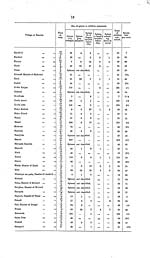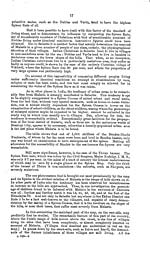Download files
Individual page:
Thumbnail gallery: Grid view | List view

16
Village or Hamlet,
Place on map.
Size of Spleen in children examined.
Total of children
examined.
Spleen rate
per cent.
Spleen not enlarged.
Spleen just palpable.
Spleen 2-3 fingers breadth below ribs.
Spleen a hand's breadth below ribs.
Spleen extending
down to navel.
Sutarwada, Hamlet of Shahad
18/G
17
1
18
5.5
Tale, Hamlet of Eksar
8/E
58
58
Nil.
Tari, Hamlet of Kolset
7/O
Spleens not classified.
27
41
Tarodi, Hamlet of Dongri
4/C
29
1
1
31
6.5
Thakur, Hamlet of Eksar
8/E
21
2
1
24
12.5
Trombay
22/L
74
1
75
1.3
Utan
5/B
194
1
1
196
1
Vakola, Hamlet of Kolhe Kalyan
19/F
53
53
Nil.
Valnai
11/E
37
4
41
9.8
Vesava
14/C
108
2
110
1.8
Vikhroli
17/K
2
3
12
8
13
38
95
Vila Parla
18/E
127
1
128
0.78
Vadavli (in Trombay)
21/I
13
7
5
2
1
28
54
Vadavli (N. of Thna)
5/M
Spleens not classified.
133
59
Wagbil, Hamlet of Kavesar
6/N
Spleens not classified.
164
42
Yerangal
13/B
60
60
Nil.
Yeur
8/L
Spleens not classified.
88
94
Total of Children examined
7,156
The Spleen Census has its Scylla and Charybdis. On the one hand, if one
strikes a percentage on a very small number of children, as one sometimes must,
if hamlets are to be taken separately from the villages to which they belong,
there is a certainty of a very obvious kind of error. On the other hand, if the
figures for a village and a small hamlet belonging to it are added together for
the purpose of striking the percentage on as large a figure as possible, though
the children of the hamlet have a larger proportion of enlarged spleens than
those of the village, the percentage struck is not accurate either, being rather
higher than that of the village, and a good deal lower than that of the hamlet.
The principle here followed has been to compound the figures for a village
and its hamlets only when there was no great difference found between the
proportions of enlarged spleens, and to employ a special sign on the map to in-
dicate a place where the rate has been calculated on a very small number of
children.
In this connection the matter of class composition in different villages and
hamlets must be alluded to. It is found, as a rule, that the poorer fed a class
or caste of people is, the more liable are its members to Malaria, and vice versa,
and the peoples of Salsette are no exception to the rule. The children of the
well-to-do commercial castes who reside in villas in Salsette for part of the year
may be left out of account : their Spleen Rate would not have been taken even
had they been in residence, as their children are not born and bred in Salsette.
Brhmins, again, form such a relatively small proportion of the inhabitants of
villages that no conclusions can be based on any figures relating to their
children. But in some villages almost the whole, and in others quite the whole
of the inhabitants are Indian Roman Catholics, and it was quite noticeable that
their higher standard of living makes them tend to have a lower Spleen Rate
than the average of cultivators. At the other end of the scale the distinctly
Village or Hamlet,
Place on map.
Size of Spleen in children examined.
Total of children
examined.
Spleen rate
per cent.
Spleen not enlarged.
Spleen just palpable.
Spleen 2-3 fingers breadth below ribs.
Spleen a hand's breadth below ribs.
Spleen extending
down to navel.
Sutarwada, Hamlet of Shahad
18/G
17
1
18
5.5
Tale, Hamlet of Eksar
8/E
58
58
Nil.
Tari, Hamlet of Kolset
7/O
Spleens not classified.
27
41
Tarodi, Hamlet of Dongri
4/C
29
1
1
31
6.5
Thakur, Hamlet of Eksar
8/E
21
2
1
24
12.5
Trombay
22/L
74
1
75
1.3
Utan
5/B
194
1
1
196
1
Vakola, Hamlet of Kolhe Kalyan
19/F
53
53
Nil.
Valnai
11/E
37
4
41
9.8
Vesava
14/C
108
2
110
1.8
Vikhroli
17/K
2
3
12
8
13
38
95
Vila Parla
18/E
127
1
128
0.78
Vadavli (in Trombay)
21/I
13
7
5
2
1
28
54
Vadavli (N. of Thna)
5/M
Spleens not classified.
133
59
Wagbil, Hamlet of Kavesar
6/N
Spleens not classified.
164
42
Yerangal
13/B
60
60
Nil.
Yeur
8/L
Spleens not classified.
88
94
Total of Children examined
7,156
The Spleen Census has its Scylla and Charybdis. On the one hand, if one
strikes a percentage on a very small number of children, as one sometimes must,
if hamlets are to be taken separately from the villages to which they belong,
there is a certainty of a very obvious kind of error. On the other hand, if the
figures for a village and a small hamlet belonging to it are added together for
the purpose of striking the percentage on as large a figure as possible, though
the children of the hamlet have a larger proportion of enlarged spleens than
those of the village, the percentage struck is not accurate either, being rather
higher than that of the village, and a good deal lower than that of the hamlet.
The principle here followed has been to compound the figures for a village
and its hamlets only when there was no great difference found between the
proportions of enlarged spleens, and to employ a special sign on the map to in-
dicate a place where the rate has been calculated on a very small number of
children.
In this connection the matter of class composition in different villages and
hamlets must be alluded to. It is found, as a rule, that the poorer fed a class
or caste of people is, the more liable are its members to Malaria, and vice versa,
and the peoples of Salsette are no exception to the rule. The children of the
well-to-do commercial castes who reside in villas in Salsette for part of the year
may be left out of account : their Spleen Rate would not have been taken even
had they been in residence, as their children are not born and bred in Salsette.
Brhmins, again, form such a relatively small proportion of the inhabitants of
villages that no conclusions can be based on any figures relating to their
children. But in some villages almost the whole, and in others quite the whole
of the inhabitants are Indian Roman Catholics, and it was quite noticeable that
their higher standard of living makes them tend to have a lower Spleen Rate
than the average of cultivators. At the other end of the scale the distinctly
Set display mode to: Large image | Zoom image | Transcription
Images and transcriptions on this page, including medium image downloads, may be used under the Creative Commons Attribution 4.0 International Licence unless otherwise stated. ![]()
| India Papers > Medicine - Disease > Report on certain features of malaria in the island of Salsette > (29) Page 16 |
|---|
| Permanent URL | https://digital.nls.uk/74577520 |
|---|




